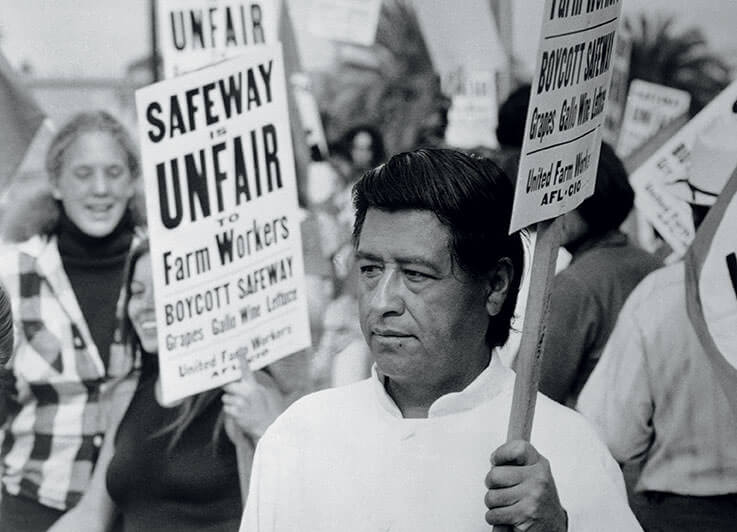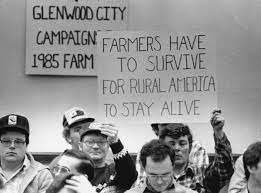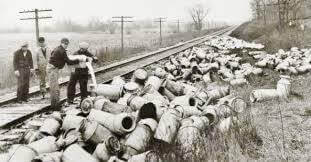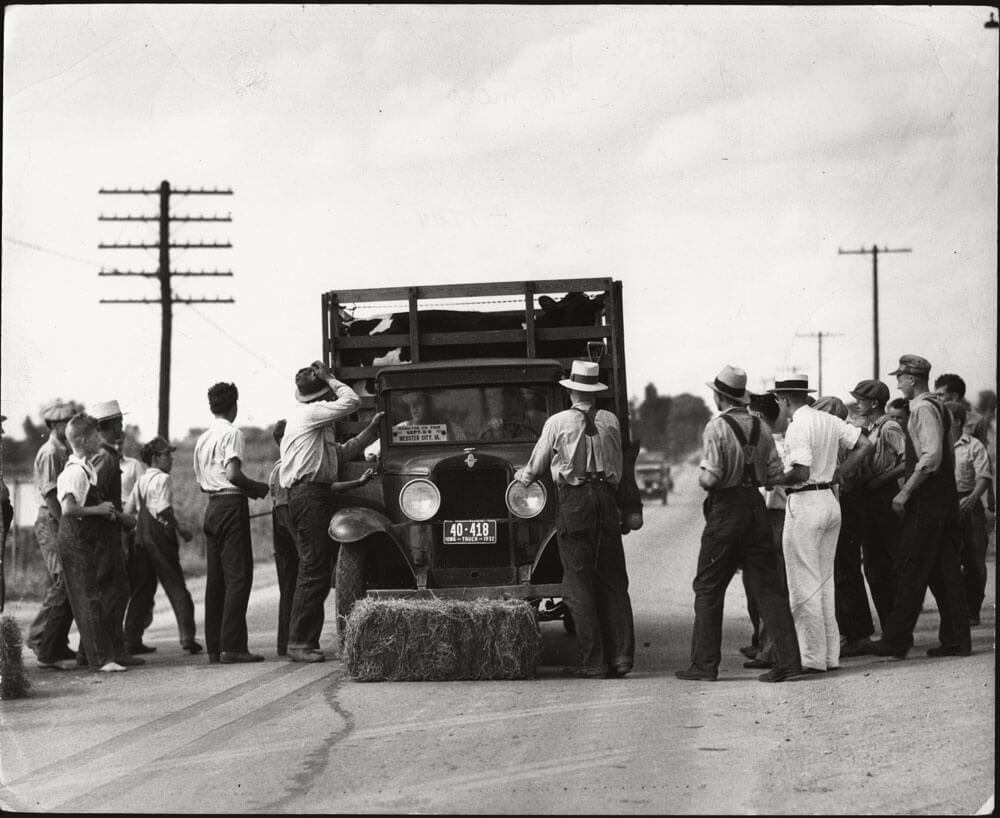Table of Contents
Joan Robinson, a renowned economist of the 20th century, uttered one of the most cogent truths of that century: “The reason to study economics is to know when economists are lying to you.”
We farmers need to recognize that the promises of most farm economists and journalists have been based on an ideology, not the science of economics. This ideology glorifies “free markets” and promises freedom and liberty, as manifested in the notorious 1996 farm bill referred to as "Freedom to Farm." What this really means is unrestrained freedom and billion-dollar profits for multinational corporations. By insisting on basing policy on this ideology, farm economists and journalists intentionally obscure the logical economic analysis of the inevitable disastrous outcomes of free markets: low incomes for family farmers, the hollowing out of rural communities, pollution of water and air, moving livestock production out of the hands of family farmers, the monopolization of food and farm input industries, and bleak futures for kids who would love to grow up to be farmers.
The reason to study economics is to know when economists are lying to you.
Any farmer you ask will have stories recounting investments gone wrong and dreams destroyed by disastrous unforeseen market crashes. My neighbor used to point to his beautiful silo and say, “There’s my monument to stupidity.” Over the last 45 years, I can’t count how many times I have cleaned out my corn and soybean bins in August getting ready for the next harvest, only to sell these bushels at the lowest price of the year, and knowing prices would be even worse at harvest. Another year of rolling the dice, my livelihood depends on the judgment of speculators and global grain processors at the casino called the Chicago Board of Trade. Is this any way to run an agricultural system?
Everything is the farmer’s fault. As an example, here is some advice farmers have gotten from an Iowa State University Extension farm management economist, quoted in a Farm News article: “For any given year, there is no magic day, week, month, or even price known until it has occurred. Most years, those spring highs happen somewhere between mid-May and mid-July. Unfortunately, most producers miss these futures price rallies because they fail to establish reasonable time or futures price targets and lack discipline in marketing their crops.” (Farm News, Fort Dodge, Iowa, June 12, 2020, page 4A). In this article, the economist doesn’t suggest any “reasonable” time or futures price targets, but does mention that we can expect a record US corn crop of 16 billion bushels. If you, as a farmer, think that 30 cents above today’s corn price is reasonable (which is still way below cost of production), but by mid-July the market goes up only 25 cents instead, you can blame yourself for lacking “discipline” (and you can also blame yourself for cleaning out those bins in August – for an even lower price). Hope there’s a crop disaster somewhere else in the world! Wait! The Nightly News shows government sanctioned burning of the Amazon rainforest to increase Brazil’s production of corn and soybeans. Ugh!
Some non-farmers ask why farmers raise the same crops year after year, often corn and soybeans, instead of something else. The answer is, “What crop could that possibly be?” Perishable crops are not an option for most farmers. Storable crops are the only practical choice, and they cover over 240 million acres in the US; fruits and vegetables only cover about 12 million acres. Any agricultural crop that doesn’t have a special premium for its direct human consumption or milling quality ends up as animal feed or as biofuel feedstock. Feed grains and oilseeds are valued simply by their content of protein, carbohydrates and oil – the champions of which are corn and soybeans. That’s why, despite disastrous prices, farmers are expected to increase production in 2020 with 97 million acres of corn and 93.5 acres of soybeans (Farm News, Ibid.)

Free Markets Don’t Lead to Farmer – or Consumer - Freedom
Media reports often sound the alarm to the environmental damage of today’s agriculture – soil erosion, water pollution, air pollution, loss of biodiversity – the list goes on. They say farmers, enticed by “subsidies” and crop insurance to raise as many bushels on as many acres as possible, make irresponsible choices. But let’s be clear: farmers don’t really have another choice. Like any enterprise in a free market economy, the only “choices” are to make more and make it cheaper – raising more crops for less and less money, with the environment paying the price.
Our “free market system” inevitably leads to overproduction on a global scale. After all, every farmer around the world in this globalized system is in a contest to increase production in order to increase income. Consequently, supply overshoots demand, resulting in low commodity prices that can't keep up with inflation, and ever-shrinking farm income. Lower farm income results in some farmers throwing in the towel or being foreclosed on. That means the remaining farmers who bravely hang in there will be farming more land and trying to increase yield. There you have it: ever larger farms using more corporate-sourced technology to increase yields, which leads to more overproduction. Is this freedom?

A question rarely posed by the media or ag economists is, “When crop prices are disastrously low, don’t the buyers benefit?” (The buyers must be the consumer, right?) Actually, with over 40,000 items now in a typical supermarket – almost all highly advertised and processed products – the price of raw materials as they leave the farm has little relation to retail prices. In fact, the “consumers” for most farmers’ crops are really giant food processing and marketing corporations, not ordinary citizens. These corporations reap a windfall when farmers’ crops sell at disastrously low prices because retail prices are generally not affected.
Besides, nearly 50 percent of corn and over 95 percent of soybean meal is fed to livestock (cattle, hogs, poultry, and dairy cows), almost exclusively owned or contracted for by giant meat processors and their vertically integrated Concentrated Animal Feeding Operations (often referred to as CAFOs, or factory farms). “Farm animals,” as we know them, are generally owned by corporations and are crowded together in giant feedlots or CAFOs. This is yet another reason farmers have few choices in what they produce. With livestock raised this way, family farmers are shut out and it is no longer (financially or contractually) an option for them to use soil-conserving and regenerating perennial hay and pasture, along with small grains for feed and bedding. When livestock were an integral element of the farm, the farmer could wisely choose to use different parts of the farm in different ways and make crop rotations the norm – rotations that saved soil, sequestered carbon, and could produce nitrogen (in the form of animal waste) for the next corn crop. These rotations also diminished the plagues of weeds and pests that result from the endless repetition of corn and soybeans – sometimes referred to as monocropping.
What We Can Learn From the Great Depression and Parity
From the early days of our country, independent family farmers were recognized as essential participants of our new democracy, and, according to noted historian Eric Foner, upholding the family farm was one of the pillars of the new Republican Party in the 1850s. The rejection of exploitation of other humans, especially the enslavement of humans of African descent, was based on the party’s dedication to justice and freedom for all. Family farmers, small business owners, and free workers recognized the limited opportunities they would have in a sick economy if slavery were to exist and expand.
Farmers of my generation heard sad, sad stories from their parents or grandparents of neighbors losing their farms in the 1920s and early 1930s. They said political leaders were indifferent to the farmers’ plight during the Roaring Twenties because exaltation of the free market ruled their thinking and policymaking. The ideology of free markets overruled common sense, so burgeoning debt, income inequality, and the depressed farm economy led to the Great Depression. The stories also included how President Franklin Delano Roosevelt, starting in 1933, was willing to challenge the titans of industry and the big banks to change the rules of the economy that had led to the worst economic disaster in history. The farm I farm and live on today was one of many saved by Roosevelt’s New Deal farm program features. I say “features” because any people-oriented legislation must be a compromise and survive the slings and arrows of big city media and establishment economists. So was the case with New Deal farm programs.
Nevertheless, the pillars of these programs were based on sound economic principles that addressed farmers’ basic needs, not just in a depression, but for all times. Farmers demanded “parity prices,” prices that maintained their purchasing power compared to a time of economic balance from 1910-1914. (Just as farmers today know that three dollars per bushel is not the same as the three dollars per bushel in 1975 when I came back to farm the family farm.) With New Deal farm programs clearly aimed at parity prices, farmers could receive a nine month non-recourse loan at 90 percent of the parity price for each storable commodity. If they were unable to sell it and pay back the loan with interest, the government would put the commodity in a food security reserve (called the Ever-Normal Granary) and the farmer could keep the loan. Therefore, no farmer would accept less than the loan rate, and the market price would always stay above that level. Non-recourse loans are important to farmers because, unlike recourse loans, the lender will not demand a farmer sell other assets if they cannot pay back their loan, giving farmers financial stability in times of pricing instability or disasters.
The Ever-Normal Granary was essential because restricting production to raise price levels could otherwise lead to food shortages and still leave the farmer guessing how high or how low prices might result, while speculators gambled with farmers’ livelihoods. The price floor was also protected from cheap imports by what was called Section 22, where the Secretary of Agriculture could limit imports if the price support mechanism was threatened.
Supply Management and Conservation as Parity
Many attempts at supply management and conservation have been tried. Yet, I believe that in exchange for a fair price, farmers would choose the simplest method that would free them from always trying to produce more and more at the expense of their sanity and the land. This would be a quota system. If a farmer were given a quota that would assign a quantity of grain for his contribution to the nation’s food supply, the farmer could then aim for that quantity, producing it with the least application of synthetic inputs while focusing on taking care of the land for future generations.
It is obvious that many of the environmental problems of modern agriculture would be eliminated by this supply management system. Land not needed for producing the usual fencerow-to-fencerow corn and soybeans, for instance, could be transformed into soil-conserving production of hay and pasture with small grains offering good feed and bedding for livestock raised on family farms instead of in corporate confinements and feedlots. Pasture and hay would include perennial legumes to generate nitrogen in the soil for the next corn crop and weed suppression would make herbicide use decline drastically. Perennial grass and legumes also sequester carbon deep in the soil, a very strong consideration regarding solutions to climate change.

Agriculture must respect everyone’s need for a nutritious and healthy diet from farms that can take care of our land and water. Unfortunately, “consumers” of our commodities today are really the multinational corporations that process and manufacture “food,” among the 44,000 items in large supermarkets. A cheap food agriculture policy like the free market policy today (propped up by taxpayer dollars) is to benefit their profits, not to make food more affordable for our citizens. Tax payer dollars in direct payments to farmers or subsidies for crop insurance are subsidies to benefit these corporations, not farmers.
If we apply economic theory that values preservation of our natural resources, health of small farm communities, and the cooperative culture of family farms, then we can recognize that we’ve been sold a false analysis. We can recognize that the current agricultural system inevitably creates what valid economics refers to as “externalities” from “market failure.” This means that the true costs of producing agricultural commodities, which should include pollution of our water, soil erosion, and the hollowing out of our rural communities, are not accounted for in the purchase prices paid by multinational corporate consumers. They are too cheap. This results in a “misallocation of resources,” another economics term that refers to the excessive quantity and consumption that result from their low prices. Commodities are too cheap and too much is being produced, creating another array of economic and environmental fallout that will saddle future generations with disastrous outcomes.

A New Era in Agriculture
Surely today’s farmers recognize that the current system of producing more and more for less and less will not create their idea of freedom and liberty or a secure future in agriculture for them or for their children. In fact, it will be only a matter of time when crop farming – like most of today’s livestock production – is replaced by corporate farming. Do we have freedom and liberty when we don’t have neighbors or small towns with churches, schools, doctors, and small businesses? Can we really look at ourselves in the mirror if we know that future generations will inherit a damaged environment and society and ask, “What were they thinking? How could they have let this happen?”
It is essential for today’s farmers to be at the lead of the new era of parity agriculture, to bring with them the experience, knowledge, and love of farming needed for future generations of farmers to farm joyously in a system we can all be proud of. Can’t we choose parity and not disparity?







